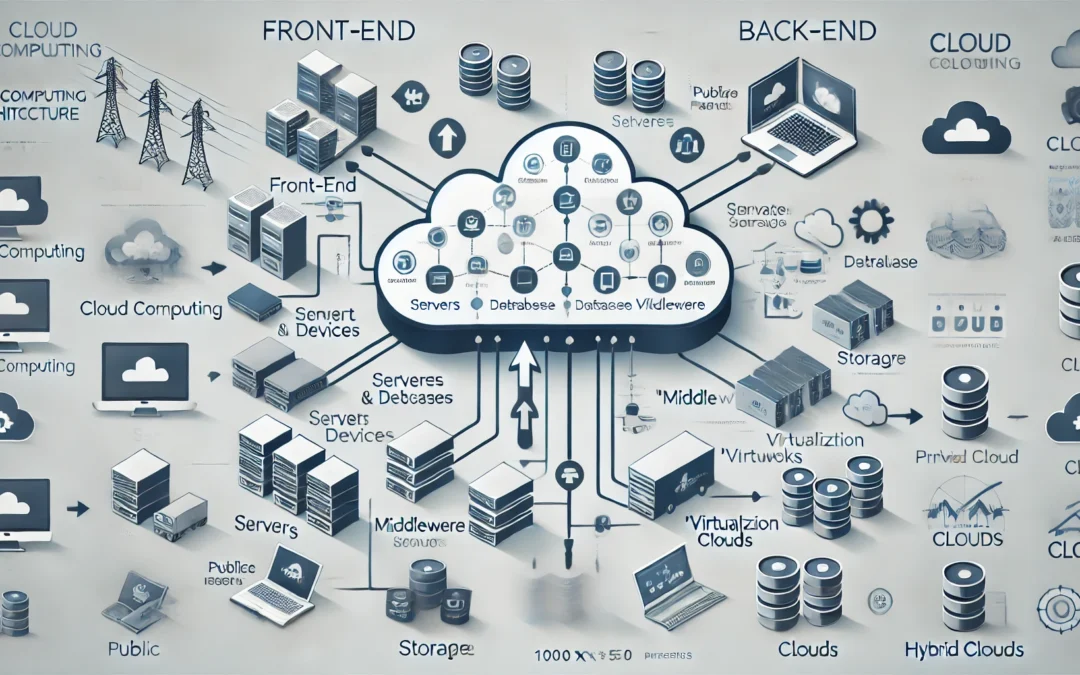What is Cloud Computing Architecture?
Cloud computing architecture is the design and structure that enables cloud computing services. It consists of various components and layers that work together to provide cloud services over the internet. At its core, cloud computing architecture includes a front-end (the client-side interface) and a back-end (the server side, where resources are managed and stored). The architecture is responsible for how data, applications, and services are stored, managed, and delivered to users remotely.
Key Components of Cloud Computing Architecture
- Front-End Components:
- This is the user-facing side, including the client’s device (like a PC or smartphone) and software interfaces used to interact with the cloud, often through web browsers or apps.
- Back-End Components:
- Servers: High-powered computers that run applications and manage data storage.
- Databases: Systems that store and organize the data accessed by users.
- Storage: The data storage systems that securely hold user data.
- Network: Connects all cloud components, allowing data exchange.
- Cloud Service: Manages the processing power and storage resources.
- Middleware:
- Middleware connects the front-end and back-end, ensuring smooth data and application management.
- Virtualization:
- Virtualization allows multiple systems to run on a single physical server, enabling resource optimization and flexibility.
Types of Cloud Computing Architectures
There are several models of cloud computing architecture, each serving different needs:
- Public Cloud Architecture: Resources and services are available to the public over the internet, shared among users.
- Private Cloud Architecture: Dedicated to one organization, providing high control, security, and customization.
- Hybrid Cloud Architecture: Combines public and private cloud features, allowing data and applications to move between them.
- Multi-Cloud Architecture: Uses multiple cloud services from different providers, often to avoid dependence on a single vendor or to optimize costs.
Advantages of Cloud Computing Architecture
- Cost Efficiency:
- Reduces or eliminates the need for expensive hardware and infrastructure, using a pay-as-you-go model that saves money.
- Scalability and Flexibility:
- Resources can be scaled up or down based on demand, making it easier to handle varying workloads without over-provisioning.
- Data Backup and Recovery:
- Automated backups in the cloud help protect data and offer quick recovery options, reducing risks of data loss.
- Accessibility and Collaboration:
- Cloud architecture enables users to access data and applications from any device with internet connectivity, making collaboration across teams and locations easier.
- Automatic Software Updates:
- Cloud providers handle system updates and maintenance, allowing users to benefit from the latest features and security improvements without downtime.
Disadvantages of Cloud Computing Architecture
- Security and Privacy Concerns:
- Although cloud providers invest in security, data stored offsite can raise concerns about unauthorized access and data breaches, especially in public clouds.
- Downtime and Dependence on Internet:
- Cloud services are dependent on internet connectivity, which means that any disruption in the internet or server downtime on the provider’s end can impact service availability.
- Limited Control and Flexibility:
- In a public cloud environment, users have limited control over their infrastructure and configurations, which may not meet the needs of every organization.
- Data Transfer Costs:
- Moving large amounts of data to and from the cloud can incur additional costs, and some cloud providers charge for bandwidth usage.
- Compliance and Regulatory Challenges:
- Certain industries, like finance and healthcare, have strict regulatory requirements for data storage and privacy. Cloud providers must meet these standards, but organizations may still face compliance challenges when using cloud services.
Conclusion
Cloud computing architecture provides a robust foundation for scalable, flexible, and cost-efficient IT solutions. However, while its advantages are considerable, understanding its potential drawbacks—such as security, internet dependency, and regulatory issues—is crucial for businesses to make informed decisions. By selecting the right cloud architecture, organizations can leverage the cloud to enhance productivity and drive innovation while managing risks effectively.
